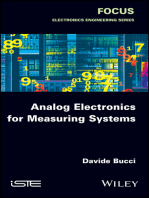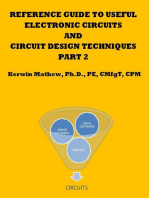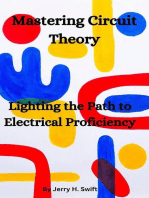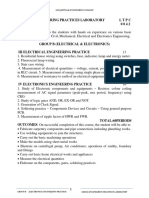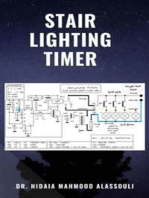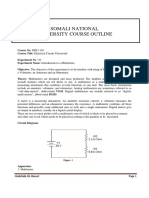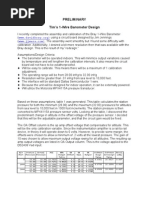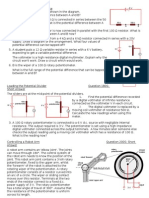Lab Report 1
Uploaded by
minasetilayeeLab Report 1
Uploaded by
minasetilayeeAddis Ababa University
Faculty of Technology
Department of Electrical and Computer Engineering
Laboratory Report
Course number: Eceg:‐ 2205 ‐ Electrical Engineering Laboratory II
Experiment Number: 01
Title: Basic Measurements
100 KΩ
100 nF
10 KΩ
1nF
10 Ω
Figure A: Circuit Layout diagram for the Laboratory Session
By: Besufekad Mekuria
Group: 1B, Subgroup 5, ID: TCR/0590/01
Date of experiment: 22, Oct, 2009
Date of submission: 4, Nov, 2009
AAU, FACULTY OF TECHNOLOGY, DEPARTMENT OF ELECTRICAL ENGINEERING, LABORATORY REPORT II 0
TABLE OF CONTENTS:
Section SubTitle Location
NO
1.1 Introduction Page Two
1.2 Objective Page Two
1.3 Preparation Page Two
1.4 Used Equipment Page Three
1.5 Components used Page Three
1.6 Theory Page Three
1.7 Procedure Page Four
1.8 Results Page Four
1.9 Semi‐log Graph Page six
1.10 Conclusion Page Seven
AAU, FACULTY OF TECHNOLOGY, DEPARTMENT OF ELECTRICAL ENGINEERING, LABORATORY REPORT II 1
Title:
Basic Network Measurements
1.1 INTRODUCTION
When working with networks in the practical world, it is important that we are
able to determine the voltages across, the currents through and in some cases the
frequency relations among the different components of the network. These
components include: resistors, capacitors, inductors, diodes, transistors, etc… and
among the measurement devices that we utilize are: CROs, multimeters, stopwatches,
etc…
1.2 OBJECTIVE
A. To go through and remember the ways of measuring the characteristics of circuits using laboratory
equipment.
B. To observe the deviation that exists between the measured values and theoretically calculated
values.
1.3 PRE‐LAB PREPARATION
Before the laboratory session, a laboratory manual was supplied by the Laboratory instructors. This
manual included a set of preliminary calculations that had to be carried out prior to the session. And
The First question asked was to calculate the DC values across the resistors in figure A.
¾ If we observe carefully, we can see that since there is no sinusoidal voltage input, the capacitors
act like a strict open, then we will get a much simpler circuit to analyze, where all three resistors
are connected in series.
¾ Then we use simple addition to find out the equivalent resistance and apply current division to
determine the DC values across each resistor.
10V DC
Applying Voltage Division
V1 = 1,000 * 10/111010 = 90mV
V2 = 10,000 * 10 /111010 = 0.9V
AAU, FACULTY OF TECHNOLOGY, DEPARTMENT OF ELECTRICAL ENGINEERING, LABORATORY REPORT II 2
V3 = 100,000 * 10 / 111010 = 9 V
V4 = 10*10/111010 = 0.9mV
1.4 USED EQUIPMENT
No Description Code/Lab Reference Quantity
1 DC Power supply (10V) ‐ 1
2 Multimeter (VOM) ‐ 1
3 Cathode Ray oscilloscope (X input) ‐ 1
4 Conducting Wires ‐ 8
8 Stop watch (Counter B 2010) ‐ 1
Table 1: Electrical Equipments that were used to set up the circuit for the laboratory procedure
1.5 USED COMPONENTS
No Description Type Quantity
1 Resistor 100KΩ 1
2 Resistor 10KΩ 1
3 Resistor 1KΩ 1
4 Resistor 10Ω 1
5 Capacitors 100 nF 1
6 Capacitor 1nF 1
7 Decade Resistor 0 ‐ 100KΩ 1
Table 2: Electrical Components that were used to set up the circuit for the laboratory procedure
1.6 THEORY
The Main theory is about how we can use the equipments to determine the required voltages,
current or another property of the circuit. Therefore
After completing setting up of the circuit, using the necessary wires and circuit board and other
circuit elements, we use the following measuring Devices:
The Cathode Ray Oscilloscope(CRO):
is a visual device that is mainly used to analyze Alternating Inputs, determine their Amplitudes, Periods
(Indirectly their Frequency), and if more than one input is connected into the different channels, it can be
used to determine their frequency relation by using a figure called a “Lissajous Pattern”.
The DC multimeter:
Is a simple numerical data displaying device that displays the current, the voltage and resistance
characteristics of the components found in a DC Circuit.
AAU, FACULTY OF TECHNOLOGY, DEPARTMENT OF ELECTRICAL ENGINEERING, LABORATORY REPORT II 3
1.7 PROCEDURE
100 KΩ
100 nF
10 KΩ
1 KΩ
1nF
10 Ω
Figure 1: Procedural diagram for the laboratory session
1. The network for the procedure was set up according to ‘Figure 1’.
2. A DC 10 Voltage was supplied to the circuit, and voltage was measured with the CRO.
3. Another AC source with 10 Vpp and frequency of 1 KHz was supplied, and VR1 was measured.
4. A similar square wave was supplied and the measurements were repeated.
5. The rise and fall times of the square wave at the output was measured.
6. The frequency response of the circuit was determined by measuring the amplitude of the output
voltage at pre determined intervals of frequency.
7. The input resistance Rii and output resistance Rio were determined.
1.8 Results
After completing setting up the network,
Table for the Measured Voltage and current values of the three resistors powered by 10 V DC
Resistor Voltage (DC meter) Voltage (CRO)
R1 0.0905V 0.1 V
R2 0.904 V 0.9 V
R3 9.04 V 10 V
R4 0.0009 V 0.001 V
AAU, FACULTY OF TECHNOLOGY, DEPARTMENT OF ELECTRICAL ENGINEERING, LABORATORY REPORT II 4
Table for the Measured frequency Response of the circuit
Frequency Output Voltage (V) Phase Angle in (0)
100 0.3 87
200 0.58 82.3
300 0.84 77.16
400 1.08 74.6
500 1.36 71.8
600 1.6 66.8
700 1.8 64.15
800 2.0 60.45
900 2.2 58.2
1000 2.4 53.1
2000 3.4 30
3000 3.75 14.4
4000 3.8 7.5
5000 3.85 0
6000 3.9 4.7
7000 3.80 9.6
8000 3.75 16.96
9000 3.7 19.47
10,000 3.6 24.6
20,000 2.7 48.6
30,000 2 56.5
40,000 1.6 61.0
50,000 1.3 66.4
60,000 1.1 73.4
70,000 0.96 Approx 90
80,000 0.84 Approx 90
90,000 0.76 Approx 90
100,000 0.68 Approx 90
Again, Graphing the measured Voltage drop as a function of the frequency of the input signal
on a Semilog Paper we get the following graph:
AAU, FACULTY OF TECHNOLOGY, DEPARTMENT OF ELECTRICAL ENGINEERING, LABORATORY REPORT II 5
1.9 Conclusion
Upon completion of the laboratory session, many observations were made; these observations have been
dealt with here under their own subheading.
Observations made from the Analysis of the network.
¾ When a square wave is added to the circuit, the output voltage shows a rise – fall characteristics.
And this phenomenon can be depicted by taking the rise time (which is the time it takes for the output
voltage to increase from 0% to 90 %) and the fall time (which is the period of time it takes for the
voltage reading at the output to decrease from 90% to 10%).
¾ Whereas if a sinusoid is input to the network, the voltage reading at the output will be a similar sinusoid
with the same frequency as that of the input signal but having a different amplitude. These can be
theoretically determined by applying the circuit simplification methods, like, Thevenin’s theorem, Mesh
and Nodal analysis.
¾ The smaller the frequency of a sinusoid, the more like a DC waveform it becomes. Because, a DC current
is nothing but a AC waveform with a frequency of “Zero”. And 1 KHz is a relatively small frequency;
hence it might be possible to determine the corresponding AC voltage and RMS values.
Observations made about practical errors encountered
It is a well known fact that there does not exist a circuit element that functions with a hundred percent
efficiency. Therefore slight deviations of the measured values from the calculated ones are to be expected under
any circumstances. However the possible causes for these irregularities include:
• The DC voltmeter does not give rise to a potential difference with a magnitude that it is programmed to do.
This is generally due to manufacturing defects, defects from improper usage and gradual wearing off.
• The leads are not of Zero Resistance; this is because of factors like: Temperature change, corrosion, etc…
• The CRO used was an analog device; therefore readings are perceptible to be misconstrued. And also
continuous mistreatment of the device leads to incorrect readings in the future.
End of Report
AAU, FACULTY OF TECHNOLOGY, DEPARTMENT OF ELECTRICAL ENGINEERING, LABORATORY REPORT II 6
You might also like
- LG 49LF5100-ZA, 49LF510V-ZA Chassis LD55C PDFNo ratings yetLG 49LF5100-ZA, 49LF510V-ZA Chassis LD55C PDF76 pages
- TB-9-2920-225-34-1 Department of The Army Technical Bulletin, 100 Amp Regulator (Solid State) NSN 2920-00900-7933, Checkout and Repair Procedures, Headquarters, Department of The Army 10 November 1981100% (2)TB-9-2920-225-34-1 Department of The Army Technical Bulletin, 100 Amp Regulator (Solid State) NSN 2920-00900-7933, Checkout and Repair Procedures, Headquarters, Department of The Army 10 November 198171 pages
- Design of Electrical Circuits using Engineering Software ToolsFrom EverandDesign of Electrical Circuits using Engineering Software ToolsNo ratings yet
- Electromagnetic Compatibility (EMC) Design and Test Case AnalysisFrom EverandElectromagnetic Compatibility (EMC) Design and Test Case AnalysisNo ratings yet
- Reference Guide To Useful Electronic Circuits And Circuit Design Techniques - Part 1From EverandReference Guide To Useful Electronic Circuits And Circuit Design Techniques - Part 12.5/5 (3)
- Impedance Spectroscopy: Theory, Experiment, and ApplicationsFrom EverandImpedance Spectroscopy: Theory, Experiment, and ApplicationsEvgenij BarsoukovNo ratings yet
- Reference Guide To Useful Electronic Circuits And Circuit Design Techniques - Part 2From EverandReference Guide To Useful Electronic Circuits And Circuit Design Techniques - Part 2No ratings yet
- Static-Inverter 1.0: A Complete Design Process to Convert D.C. to A.C. Electricity Using the Astable-MultivibratorFrom EverandStatic-Inverter 1.0: A Complete Design Process to Convert D.C. to A.C. Electricity Using the Astable-MultivibratorNo ratings yet
- Mechanical Characterization of Materials and Wave Dispersion: Instrumentation and Experiment InterpretationFrom EverandMechanical Characterization of Materials and Wave Dispersion: Instrumentation and Experiment InterpretationYvon ChevalierNo ratings yet
- Protection of Substation Critical Equipment Against Intentional Electromagnetic ThreatsFrom EverandProtection of Substation Critical Equipment Against Intentional Electromagnetic ThreatsNo ratings yet
- Electricity in Fish Research and Management: Theory and PracticeFrom EverandElectricity in Fish Research and Management: Theory and PracticeNo ratings yet
- It Is Quite Another Electricity: Transmitting by One Wire and Without GroundingFrom EverandIt Is Quite Another Electricity: Transmitting by One Wire and Without GroundingNo ratings yet
- Basic Electronics Engineering Lab ManualNo ratings yetBasic Electronics Engineering Lab Manual95 pages
- Experiment1: Introduction To Laboratory Equipment and Basic ComponentsNo ratings yetExperiment1: Introduction To Laboratory Equipment and Basic Components7 pages
- Lab 2: AC Measurements-Capacitors and Inductors: Prerequisite Reference MaterialsNo ratings yetLab 2: AC Measurements-Capacitors and Inductors: Prerequisite Reference Materials10 pages
- VSC-FACTS-HVDC: Analysis, Modelling and Simulation in Power GridsFrom EverandVSC-FACTS-HVDC: Analysis, Modelling and Simulation in Power GridsNo ratings yet
- Class XII Physics Practical File 2024-25No ratings yetClass XII Physics Practical File 2024-2534 pages
- Electronics Components: Characteristics and Measurements100% (1)Electronics Components: Characteristics and Measurements19 pages
- Wavelet Analysis and Transient Signal Processing Applications for Power SystemsFrom EverandWavelet Analysis and Transient Signal Processing Applications for Power SystemsNo ratings yet
- Somali National University Course Outline: Abdullahi Ali AhmedNo ratings yetSomali National University Course Outline: Abdullahi Ali Ahmed21 pages
- Principles of Electrical Engineering - 2013No ratings yetPrinciples of Electrical Engineering - 201397 pages
- Active Cell Balancing Basics (Capacitor)No ratings yetActive Cell Balancing Basics (Capacitor)5 pages
- Physics: Unit: 4PH0 Science (Double Award) 4SC0 Paper: 1PRNo ratings yetPhysics: Unit: 4PH0 Science (Double Award) 4SC0 Paper: 1PR32 pages
- Mobile Phone Battery Charger With Emergency Light100% (2)Mobile Phone Battery Charger With Emergency Light7 pages
- Electronic Theory: AC Electric Motor Working PrincipleNo ratings yetElectronic Theory: AC Electric Motor Working Principle14 pages
- 22-09-2024 Sr.2hrs Prog (Jee Apex) Jee Mains Q.paperNo ratings yet22-09-2024 Sr.2hrs Prog (Jee Apex) Jee Mains Q.paper12 pages
- Activity 1.1.4 Component Identification: Analog0% (1)Activity 1.1.4 Component Identification: Analog6 pages
- 1300 Edi Full Aug 2006 First Part (Shrunk+)100% (24)1300 Edi Full Aug 2006 First Part (Shrunk+)84 pages
- Unipolar To Bipolar Analog Voltage ConversionNo ratings yetUnipolar To Bipolar Analog Voltage Conversion20 pages
- A Guide to Electronic Maintenance and RepairsFrom EverandA Guide to Electronic Maintenance and Repairs
- Switching in Electrical Transmission and Distribution SystemsFrom EverandSwitching in Electrical Transmission and Distribution Systems
- TB-9-2920-225-34-1 Department of The Army Technical Bulletin, 100 Amp Regulator (Solid State) NSN 2920-00900-7933, Checkout and Repair Procedures, Headquarters, Department of The Army 10 November 1981TB-9-2920-225-34-1 Department of The Army Technical Bulletin, 100 Amp Regulator (Solid State) NSN 2920-00900-7933, Checkout and Repair Procedures, Headquarters, Department of The Army 10 November 1981
- Design of Electrical Circuits using Engineering Software ToolsFrom EverandDesign of Electrical Circuits using Engineering Software Tools
- Electromagnetic Foundations of Electrical EngineeringFrom EverandElectromagnetic Foundations of Electrical Engineering
- Electromagnetic Compatibility (EMC) Design and Test Case AnalysisFrom EverandElectromagnetic Compatibility (EMC) Design and Test Case Analysis
- Reference Guide To Useful Electronic Circuits And Circuit Design Techniques - Part 1From EverandReference Guide To Useful Electronic Circuits And Circuit Design Techniques - Part 1
- Impedance Spectroscopy: Theory, Experiment, and ApplicationsFrom EverandImpedance Spectroscopy: Theory, Experiment, and Applications
- Reference Guide To Useful Electronic Circuits And Circuit Design Techniques - Part 2From EverandReference Guide To Useful Electronic Circuits And Circuit Design Techniques - Part 2
- Static-Inverter 1.0: A Complete Design Process to Convert D.C. to A.C. Electricity Using the Astable-MultivibratorFrom EverandStatic-Inverter 1.0: A Complete Design Process to Convert D.C. to A.C. Electricity Using the Astable-Multivibrator
- Mechanical Characterization of Materials and Wave Dispersion: Instrumentation and Experiment InterpretationFrom EverandMechanical Characterization of Materials and Wave Dispersion: Instrumentation and Experiment Interpretation
- Complete Electronics Self-Teaching Guide with ProjectsFrom EverandComplete Electronics Self-Teaching Guide with Projects
- Protection of Substation Critical Equipment Against Intentional Electromagnetic ThreatsFrom EverandProtection of Substation Critical Equipment Against Intentional Electromagnetic Threats
- Electricity in Fish Research and Management: Theory and PracticeFrom EverandElectricity in Fish Research and Management: Theory and Practice
- Immittance Spectroscopy: Applications to Material SystemsFrom EverandImmittance Spectroscopy: Applications to Material Systems
- Analog Dialogue, Volume 48, Number 1: Analog Dialogue, #13From EverandAnalog Dialogue, Volume 48, Number 1: Analog Dialogue, #13
- It Is Quite Another Electricity: Transmitting by One Wire and Without GroundingFrom EverandIt Is Quite Another Electricity: Transmitting by One Wire and Without Grounding
- Exercises in Electronics: Operational Amplifier CircuitsFrom EverandExercises in Electronics: Operational Amplifier Circuits
- Experiment1: Introduction To Laboratory Equipment and Basic ComponentsExperiment1: Introduction To Laboratory Equipment and Basic Components
- Lab 2: AC Measurements-Capacitors and Inductors: Prerequisite Reference MaterialsLab 2: AC Measurements-Capacitors and Inductors: Prerequisite Reference Materials
- VSC-FACTS-HVDC: Analysis, Modelling and Simulation in Power GridsFrom EverandVSC-FACTS-HVDC: Analysis, Modelling and Simulation in Power Grids
- Electronics Components: Characteristics and MeasurementsElectronics Components: Characteristics and Measurements
- Wavelet Analysis and Transient Signal Processing Applications for Power SystemsFrom EverandWavelet Analysis and Transient Signal Processing Applications for Power Systems
- Somali National University Course Outline: Abdullahi Ali AhmedSomali National University Course Outline: Abdullahi Ali Ahmed
- Physics: Unit: 4PH0 Science (Double Award) 4SC0 Paper: 1PRPhysics: Unit: 4PH0 Science (Double Award) 4SC0 Paper: 1PR
- Electronic Theory: AC Electric Motor Working PrincipleElectronic Theory: AC Electric Motor Working Principle
- 22-09-2024 Sr.2hrs Prog (Jee Apex) Jee Mains Q.paper22-09-2024 Sr.2hrs Prog (Jee Apex) Jee Mains Q.paper









